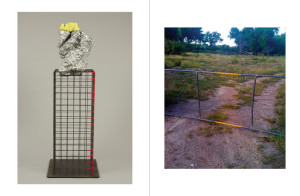Every Saturday morning when my brother and I were growing up, we’d go to the newsagents to each buy a shiny pack of stickers for our collections. For me it was Top of the Pops and for him it was the Premiership League. He was more dedicated than me and would always stick them in the album provided, whilst I often found places like my desk, my door, my bunk bed, my books, my clothes and occasionally my body to house them. Their stickiness marked my habitat, leaving grey smudges where they had fallen off, slowly peeled away or been replaced; only a few ever remained clinging to where they had been originally stuck.
All posts by Elizabeth Graham
Wanting Is Easier Than Having, Debra Baxter and Additive Process
Below is an extract from the opening text SOMETHING LIKE A PHENOMENA in Debra Baxter’s artist book Wanting Is Easier Than Having. Baxter’s description of how she moves through the world and her process of making speaks to Pat’s ideas of ‘noticing with the body’ and Alice’s thoughts on the power of objects – in particular the ability to form (or break in Baxter’s example) relationships between yourself and others.
–
I opened the door. He looked nervous as he stepped inside my apartment. Just inside the door hanging on a nail was an amulet, or more accurately, a piece of thrift store jewelry. It had a thick chain, a horseshoe shape, and a large iridescent green stone in the center. I saw him look at it and I said “It has powers”.
I could see the color drain from his face. He told me I was delusional. He looked at the amulet and said that it was a piece of junk. Clearly, any hope for our date ended then and there.
What he failed to understand was the power of objects – real or imagined. I have spent close to 17 years since that date trying to make powerful objects and trying to understand what makes certain objects feel more potent than others.
Power is certainly not the only goal of my making, nor is “power” the only word for what I’m cultivating. I’m invested in energy, potency, strength, momentum, and reaching for the opposite; in finding strength in vulnerable places. Pressing opposites against each other is a large part of my practice. Over the years these themes keep surfacing:
Inhaling – Exhaling
Believing in – Giving up
Wanting – Having
Protected – Exposed
Something like a phenomena. Like the Yeah Yeah Yeah’s song, my work is grounded in a bodily experience – a phenomenon that is indescribable that slides into the divine. In a interview Shirazeh Houshiary describes the sublime in her work:
“The object and the images which the artist creates have their place in the external world, but their essence and meaning are conceived in an inner world, and this internal world is an intermediate space between body and soul… So that the finished work is a real experience of continual becoming. Art making is subject to movement and ascension and descension, it it not born of the body, it becomes it.”
This becoming is how I make my way through the world. The way I experience making and seeing art is through my body. When I love a piece of art, I become physically stirred by it. I have a feeling in the pit of my stomach or an expansion in my chest, and it’s hard to put it into words.
–
Later in the book in a text called PLUS AND MINUS Sara Krajewski describes Baxter’s practice as an ‘additive process’, a process that sees ‘adding’ as suggesting wanting – the desire to have and hold something or someone. An acquisitive moment. Krajewski then describes ‘subtracting’ as a realization of ‘the fear of having, once you hold something, the thought of losing it haunts you.’ I think this PLUS AND MINUS or ‘additive’ process relates to Alice’s post about gathering/stickiness/persistence and how noticing not only moves forwards, but also backwards, sideways and around.
